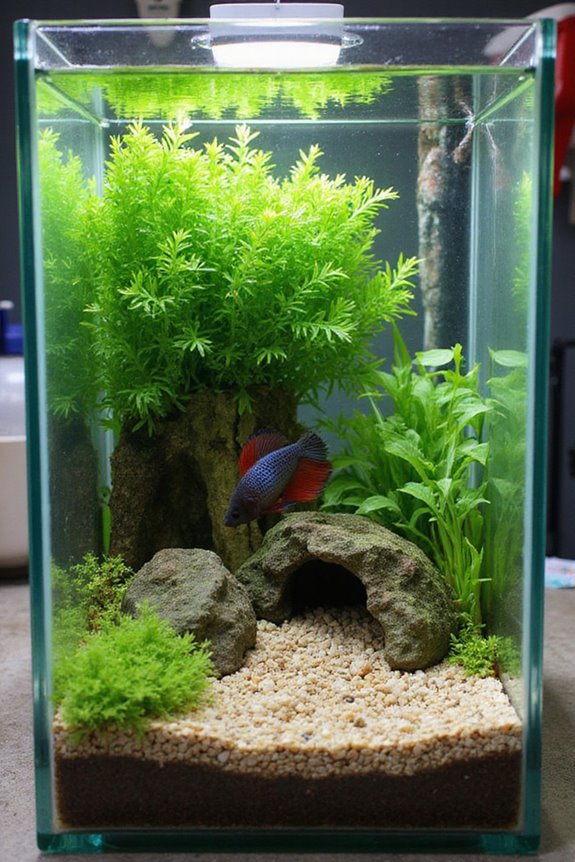Cloudy water in your fish tank can arise from bacterial blooms, overfeeding, or algae growth. I recommend checking your water parameters for ammonia and nitrites, as these can spike in an immature tank. To fix the issue, perform regular water changes, ideally 10-20% weekly, and vacuum the substrate to remove waste. Adjust your feeding habits; only give what your fish can consume in a few minutes. There are effective clarifiers available if needed; more solutions await you soon.
Key Takeaways
- Cloudy water often results from bacterial blooms due to overfeeding or decaying organic matter in the tank.
- New Tank Syndrome can cause cloudy water from immature biological filtration, leading to spikes in ammonia and nitrites.
- Regularly test water parameters like ammonia and nitrates to manage water quality and prevent cloudiness.
- Perform weekly water changes of 10-20% to dilute excess nutrients and maintain clarity in the tank.
- Avoid overfeeding by providing only what fish can consume in a few minutes to prevent decomposition and cloudiness.
Understanding Cloudy Water: An Overview
When you first set up a fish tank, it’s common to encounter cloudy water, which can be a bit concerning. This cloudiness often results from bacterial blooms, where beneficial bacteria rapidly multiply, feeding on the minerals and nutrients present in your aquarium. Typically, this happens within the first few days to a week after setup. You’ll notice a milky or white haze suspended in the water, which signals that your tank is still establishing its biological balance. Fortunately, this condition usually resolves itself as the beneficial bacteria mature and stabilize. To help speed up the process, make certain your filtration system is running efficiently and avoid overfeeding, as excess organic waste can fuel further bacterial growth.
Common Causes of Cloudy Fish Tank Water
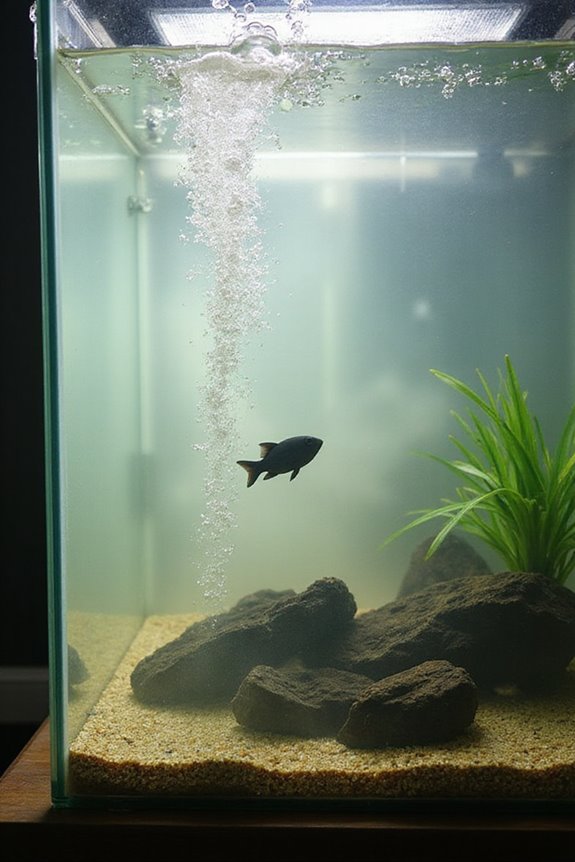
Cloudy water in a fish tank can stem from several common causes, each requiring specific attention to restore clarity. One significant culprit is a bacterial bloom, often triggered by overfeeding or decaying organic matter. This results in a milky appearance, but it typically resolves as the nitrogen cycle stabilizes. Algae growth is another common cause, manifesting as greenish water due to excess nutrients and light. To combat these issues, I recommend reducing feeding amounts and promptly removing uneaten food. Regularly testing water parameters, such as ammonia and nitrates, can help manage both bacterial and algae issues. Additionally, ensuring proper filtration will aid in maintaining clear water and a healthy environment for your fish.
The Impact of New Tank Syndrome
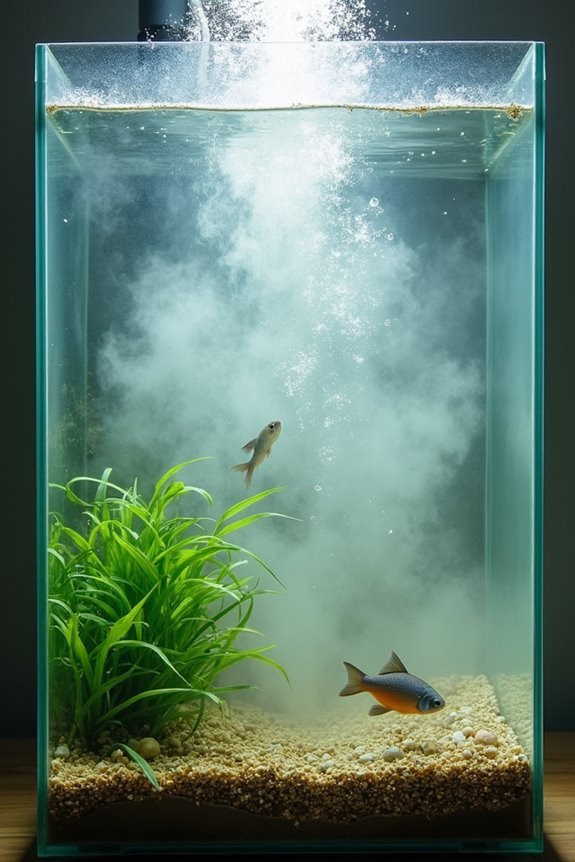
New Tank Syndrome can greatly impact your aquarium’s health, especially in the crucial early weeks after setup. This condition arises from an immature biological filtration system, leading to a bacterial imbalance. During the initial cycling phase, ammonia and nitrites can spike to toxic levels, stressing your fish and clouding the water. You might notice symptoms like lethargy or a cloudy appearance in the tank. To manage this, test your water parameters regularly, focusing on ammonia and nitrite levels. Consider cycling the tank for 4 to 6 weeks before adding fish, or introduce them gradually. Using a quality filter and ensuring regular water changes can help establish beneficial bacteria, ultimately preventing the onset of new tank syndrome and maintaining clear water.
Overfeeding and Its Consequences
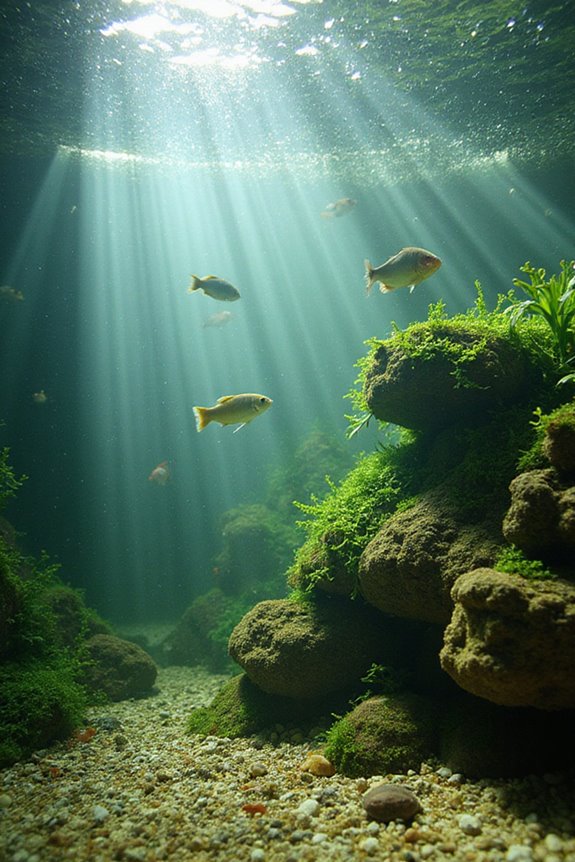
Overfeeding can significantly disrupt the balance in your aquarium, leading to a range of issues that affect both water clarity and fish health. When I overfeed, uneaten food decomposes, releasing organic waste that clouds the water and encourages bacterial blooms. This not only decreases oxygen levels but also raises ammonia and nitrite concentrations. Elevated toxins impair gill function and stress fish, making them more susceptible to diseases. The decreased dissolved oxygen causes lethargy, and fish may gasp for air at the surface. Additionally, excess nutrients promote algae growth, further clouding the water. To maintain clarity and your fish’s well-being, I’ve found that feeding only what they can consume in a few minutes is key.
The Role of Filtration in Water Clarity
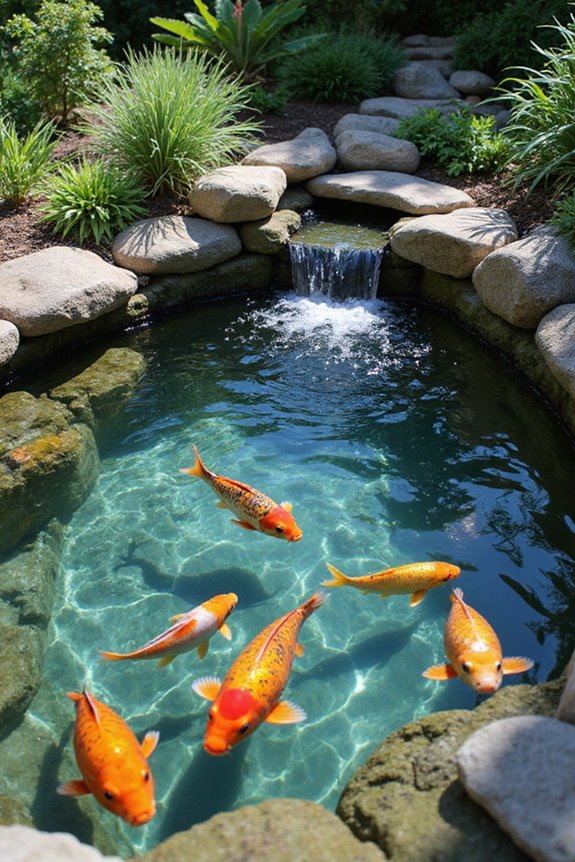
Filtration plays an essential role in maintaining clear water in your aquarium, as it helps remove particles and impurities that can cloud the environment. Different filtration types impact clarity, with canister filters generally offering superior performance due to their larger media volume. I recommend using mechanical filtration, like filter floss or sponges, to effectively trap particulate matter. For best results, make sure you have about 100 square feet of filter media surface area per pound of fish. Regular maintenance is vital; clean or replace filter media after cloudiness clears to maintain efficiency. Additionally, consider using flocculants to bond fine particles, making them easier to capture. Following these maintenance tips will help keep your tank crystal clear.
Biological Factors Contributing to Cloudiness
When establishing a healthy aquarium, it’s vital to recognize how biological factors can lead to cloudiness in the water. Bacterial proliferation often occurs in tanks under six weeks old, where the ecosystem is not yet balanced. If you notice cloudy water, it could be due to free-floating bacteria multiplying in nutrient-rich conditions. Overfeeding your fish adds organic waste, which can further contribute to cloudiness. It’s important to monitor ammonia and nitrite levels, as they often accompany bacterial blooms. Additionally, detritus trapped in the substrate can decompose, releasing compounds that promote bacterial growth. Regularly vacuuming the substrate and removing uneaten food help maintain water clarity and prevent nutrient imbalances, fostering a healthier environment for your fish.
Effective Fixes for Cloudy Water
Cloudy water can be a frustrating issue in any aquarium, and addressing it effectively requires a systematic approach. First, I perform regular water changes, about 10-20% weekly, using a water changer tool to remove debris from the substrate. This helps dilute excess nutrients. Next, I guarantee proper filter maintenance; I clean or replace filter media as needed and consider adding activated carbon. Substrate cleaning is essential, so I vacuum it regularly to remove organic waste. I also manage overfeeding by only giving my fish what they can consume in a few minutes. Finally, I use water conditioners and clarifiers to tackle cloudiness quickly. Monitoring water parameters guarantees a safe environment for my aquatic life.
Prevention Strategies for a Clear Aquarium
To keep your aquarium clear, I find that implementing effective prevention strategies is essential. First, I make sure to choose a filter that’s rated for my tank size, using multi-stage filtration that targets various contaminants. Regular preventative maintenance includes cleaning or replacing filter media monthly. I perform weekly water changes, replacing 10-20% of the tank volume, and I always use water conditioners to prepare tap water. When feeding my fish, I only offer what they can consume in a few minutes to minimize waste. For substrate care, I thoroughly rinse sand or gravel before adding it to my tank. Finally, I avoid disturbing the substrate too much during cleaning to limit cloudiness and maintain a stable environment for beneficial bacteria.
When to Seek Professional Help
Recognizing the right time to seek professional help can make a significant difference in maintaining a healthy aquarium. If your tank’s cloudiness persists for more than two weeks, it’s time to contemplate professional assistance. Unusual fish behavior or signs of illness are also red flags indicating poor water quality. Repeated tests showing abnormal ammonia or nitrite levels, despite regular maintenance, warrant expert evaluation. If you’ve cleaned the tank and still experience recurring cloudiness, don’t hesitate to consult a specialist. Additionally, mechanical issues with filters or UV sterilizers can lead to long-term problems. In these situations, professional analysis can guarantee your water conditions are safe and suitable for your fish.
Frequently Asked Questions
Can Cloudy Water Harm My Fish or Aquarium Plants?
I’ve found that cloudy water can affect fish health and plant growth indirectly. While it’s usually not toxic, it indicates an imbalance that can stress fish and hinder plants’ ability to photosynthesize effectively.
How Long Will It Take for Cloudy Water to Clear Up?
It usually takes one to two weeks for cloudy water to clear up. I’ve noticed that bacterial blooms and filtration issues can slow this process, but patience and proper maintenance really help restore clarity in my tank.
What Specific Fish Species Cause Substrate Disturbance?
Picture a bustling underwater city. Bottom dwellers like Geophagus and catfish stir up the substrate, while surface swimmers add to the charm. Their natural behaviors create a dynamic ecosystem, but diligent maintenance keeps everything harmonious.
Are There Safe Chemical Treatments for Cloudy Water?
I’ve found that chemical filtration methods like activated carbon and Purigen, along with solid aquarium maintenance tips, can really help clear cloudy water effectively while keeping my fish safe and healthy.
How Often Should I Test My Aquarium Water Parameters?
I believe regular water testing is essential for maintaining parameter consistency. In my experience, testing every 2 to 4 weeks works well for established tanks, while new ones need daily checks during the cycling period.


